The best yellow and orange sweet bell peppers for outdoor and greenhouses
Somehow it happened that the pepper should be red, however, the same goes for tomatoes. But it is the yellow suns that are truly capable of giving your garden a certain zest. In addition, it is always nice to decorate salad and twists with vegetables of bright colors. As for the beneficial properties, it is in the yellow peppers that rutin is the most, an element that makes blood vessels more elastic and strengthens their walls. Also, yellow varieties have more potassium and phosphorus.
Interesting! Peppers achieve a yellow (orange) hue precisely in their biological ripeness, while in technical they, like red ones, are most often greenish-white, green or dark green.
There are a lot of varieties of yellow or orange peppers, so we will focus only on their most popular = proven representatives.The following is an overview of the descriptions and characteristics of the very best yellow (orange) peppers.
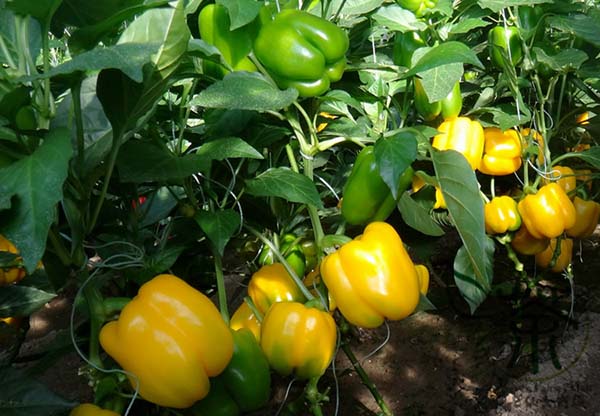
The best yellow (orange) varieties and hybrids of peppers: top 15 most popular
Note! The list of the best seeds of yellow (orange) peppers for open ground and greenhouses was prepared based on the degree of popularity of the names of varieties and hybrids, analysis of reviews of experienced gardeners, as well as the personal opinion of the author.
The best varieties of peppers with yellow or orange fruits for growing outdoors and greenhouses are (alphabetically):
By the way! The most popular variety of orange (yellow) bell pepper is Big Mamafollowed by Gemini, Orange Wonder, Golden Wonder and Orange Bull.
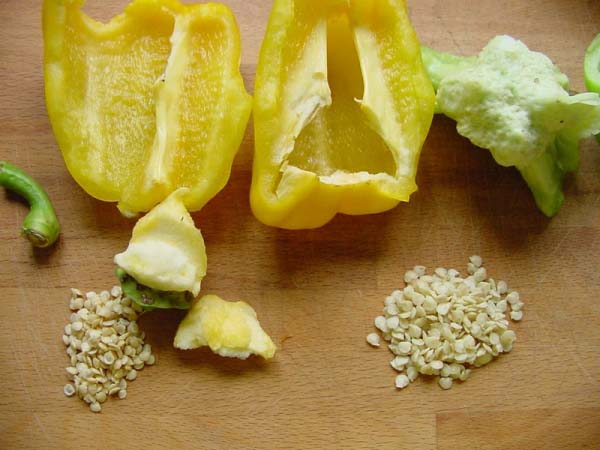
Important to remember, what collect seed (prepare seeds) can only with varietal peppers, hybrid seeds are not suitable for re-sowing. their maternal signs are split and you 100% will not get what you planted last year. However, hybrid peppers, usually, more resistant to disease and always bring decent harvest.
White gold
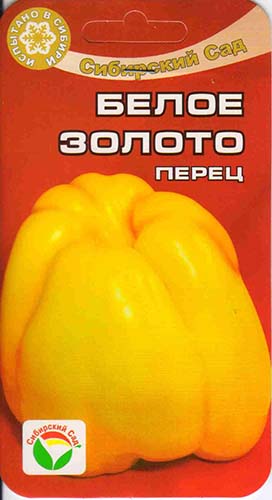
- The variety is early maturing.
- For greenhouses and open ground.
- The plant is closed, of medium height (40-50 cm).
- The fruit is directed horizontally, prismatic, low gloss, color in technical ripeness is greenish-white, in biological it is light yellow. The number of nests is 3-4.
- Wall thickness - 6.6 mm (maximum - up to 10 mm).
- Weight - 104 g (maximum up to 450 grams).
- Productivity - 4.2 kg per sq.m.
- Good delicate spicy taste.
- Universal purpose.
Big Mama
By the way! There is also a purple-colored Big Papa.
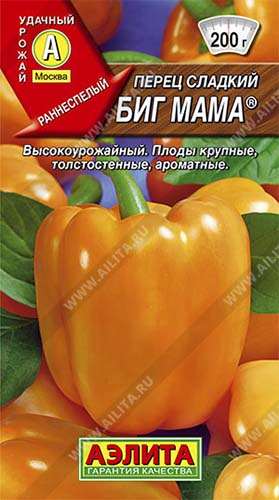
- The variety is early maturing. The first crop is harvested 110-115 days after germination.
- For open ground and greenhouses.
- Plants in the open field are compact, 50 cm high, in the greenhouse they are more spreading - up to 100 cm.
- The fruit is drooping, cylindrical, highly glossy, the color in technical ripeness is dark green, in biological it is orange.
- The walls are 7-8 mm thick.
- Weight - 150-200 g.
- Productivity - up to 7-8 kg per sq.m.
- Fruity sweet, juicy and aromatic.
- Resistant to diseases, tolerates low temperatures and lack of light well.
- Bears fruit for a long time, until the first frost.
Bull
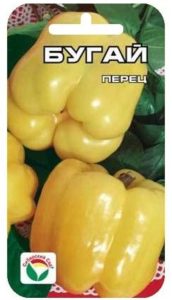
- The variety is early maturing.
- Suitable for growing in greenhouses and outdoors.
- The bush is strong, 50-60 cm high.
- The fruit is drooping, cuboid, glossy, color in technical ripeness is greenish-white, in biological ripeness it is yellow with pearl tint.
- Wall thickness - up to 10 mm.
- Weight - up to 500 grams.
- Fruits of excellent delicate spicy taste, retain their appearance and shine for a long time.
- Universal purpose.
Gemini F1
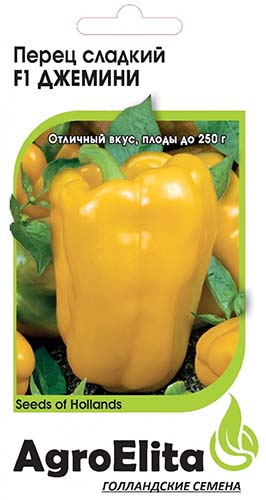
- Medium early hybrid.
- For growing in the open field and under film shelters.
- The plant is semi-spreading, erect.
- The fruit is drooping, cylindrical, glossy, green in technical ripeness, yellow in biological ripeness. The number of nests is 2-3.
- Wall thickness - 5.5-7.0 mm.
- Fruit weight - 90-250 g.
- Productivity - 3.0-5.0 kg per sq.m.
- The taste is excellent.
- By its purpose, the variety is universal: it is used both fresh for the preparation of salads and for other culinary dishes and preservation.
- Heat resistant. Resistant to potato virus.
Yellow bell
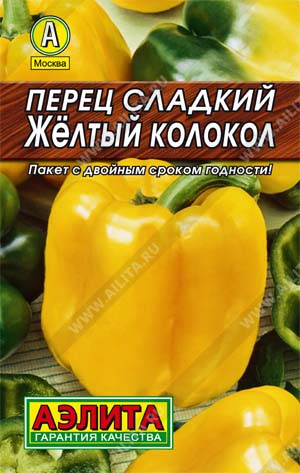
- The variety is mid-season. The period from planting seedlings to fruiting is 70-75 days.
- For open ground and foil greenhouses.
- Semi-spreading plants, height in open field 70-75 cm.
- The fruit is drooping, bell-shaped, three-tetrahedral, 12 cm high. The color of the fruit in technical ripeness is green, in biological ripeness it is golden yellow.
- Wall thickness - 4.5-5.2 mm.
- Weight - 120-170 g.
- Productivity - up to 8 kg per sq.m
- High taste.
- Universal use.
- The variety is resistant to tobacco mosaic virus, potato virus. Ties fruit well with changes in air temperature.
Golden miracle
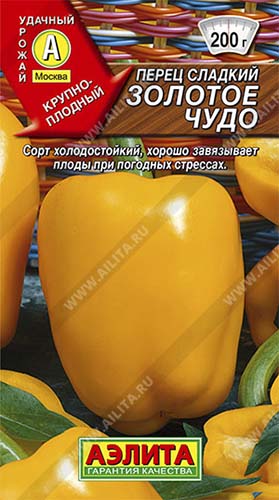
- The variety is mid-season (115-130 days).
- For open ground and film shelters.
- Plants of medium height, semi-spreading.
- The fruit is drooping, prismatic, highly glossy, the color in technical ripeness is green, in biological ripeness it is dark yellow. The number of nests is 3-4.
- Wall thickness - 7 mm.
- Weight - 185 grams.
- Productivity - 2.6 kg per sq.m.
- The taste is good.
- Universal use: fresh, home cooking and canning.
- Relatively cold-resistant. Fusarium resistant.
Golden Taurus
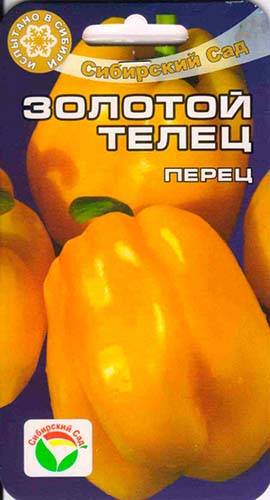
- Medium early variety.
- For growing in the open field and under film shelters.
- The bush is undersized, 70-75 cm high.
- The fruit is drooping, cuboid, highly glossy, dark green in technical ripeness, and dark orange in biological ripeness. The number of nests is 3-4.
- Wall thickness - 7-10 mm.
- Weight - 104-173 g (maximum up to 250-500 grams).
- Productivity - 2.5-3.3 kg per sq.m.
- The taste is very high.
- Recommended for fresh use, for home cooking and canning.
Golden anniversary
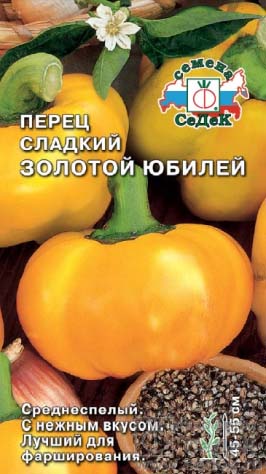
- The variety is mid-season (111-115 days).
- For open and protected ground.
- The plant is compact, 45-55 cm high.
- Fruits are large, round-flat, slightly ribbed, glossy, green in technical ripeness, golden yellow in biological ripeness.
- Wall thickness - 8.5-10 mm.
- Weight - 110-180 g.
- The taste is excellent, the fruits are tender.
- Recommended for fresh consumption, for all types of culinary processing, especially for stuffing.
- Resistant to verticillary wilt.
Oriole
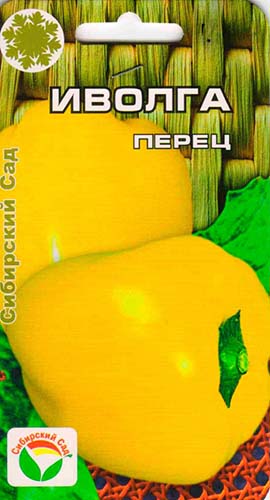
- The variety is early maturing. From germination to technical ripeness - 110-115 days (according to other sources, 80-105 days).
- For open ground and film shelters.
- The plant is a standard plant, medium-sized, semi-spreading.
- The position of the fruit on the plant is sticking up. The fruit is heart-shaped, smooth, glossy. In technical ripeness the color is green, in biological it is yellow. The number of nests is 3-4.
- Wall thickness - 6-7 mm.
- Weight - 64-85 g (according to other sources, 120-135 grams).
- Productivity - 6-11 kg per sq.m.
- Taste is good and excellent, aroma is weak
- Able to set fruit in low light and temperature conditions.
Indalo F1
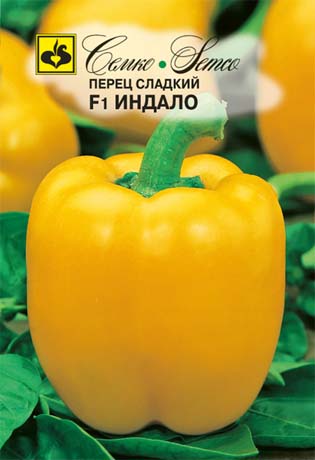
- Medium early hybrid. From germination to technical ripeness 105-110 days, to biological 125-130 days.
- For glass and film greenhouses. Also suitable for growing outdoors and under plastic with a garter to the support.
- The plant is indeterminate, up to 1.5–2 m high.
- The fruits are cuboid, 12x12 cm, of a beautiful bright yellow color, dense, glossy.
- Wall thickness - up to 10 mm.
- Weight - over 280 g.
- Productivity depending on growing conditions - 7-14 kg per sq.m.
- The taste is excellent.
- Resistant to tobacco mosaic virus.
Orange chanterelle F1
By the way! There are more modern (2017) varieties (not hybrids) - Yellow and red chanterelle.
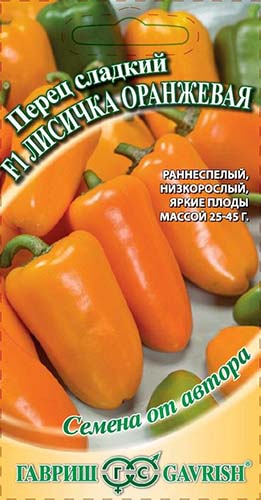
- Early ripe hybrid (100-105 days from germination to technical ripeness, 130-135 days - to biological).
- Recommended for cultivation in film greenhouses and as a pot culture for balconies and window sills, grows well on vegetable beds and curbs.
- The bush is undersized, compact with an abundance of bright, sparkling fruits.
- Fruits are cone-shaped, small. The color of the fruits is light green in technical ripeness, and orange in biological ripeness. The number of nests is 2.
- Wall thickness - 5-6 mm
- Weight - 25-45 g.
- The yield of one plant is 0.8-1.0 kg.
- The pulp is sweet, with a pungent spicy aroma.
Orange Wonder F1
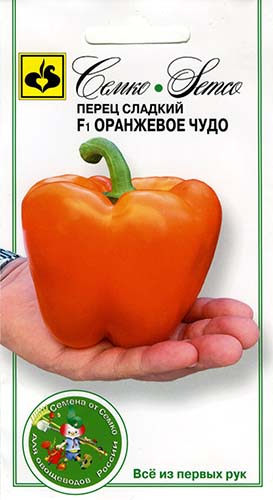
- Early hybrid. From germination to technical ripeness of fruits 100-110 days.
- The plant is vigorous, with a compact habit, indeterminate; when formed in 2-3 stems, the height reaches 1.5-2 m.
- The fruits are cuboid, 11x11 cm in size, dark green in technical ripeness, orange, glossy in biological ripeness. The number of nests is 3-4.
- Wall thickness - up to 10 mm.
- Weight - 200-220 g.
- Productivity - 8–12 kg per sq.m.
- The taste of the peppers is excellent, the marketability is high.
- Resistant to tobacco mosaic virus and tomato bronze. It tolerates temperature stresses well and has a high fruit set.
Orange bull
By the way! There is also the Red Bull variety.
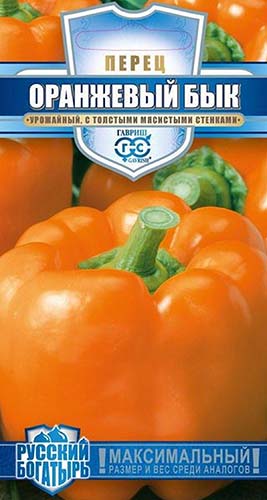
- Early variety (100-110 days from germination to the beginning of fruiting). According to other sources, it is mid-season.
- For growing under temporary film shelters and in the open field.
- Forms a bush 80-110 cm high.
- The fruits are large, cuboid, green in technical ripeness, bright orange in biological ripeness. The number of nests is 3-4.
- Wall thickness - up to 10 mm.
- Weight - 250 g (maximum up to 300-400 grams).
- Productivity - 7.0-14.0 kg per sq.m.
- Recommended for fresh consumption, stuffing, freezing and canning.
- Resistant to tobacco mosaic virus.
Orange Lion F1
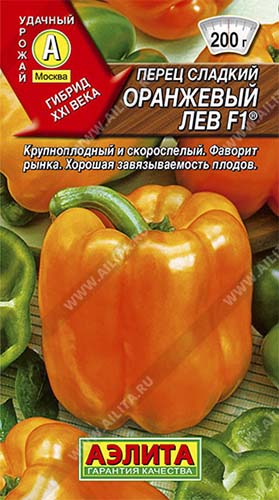
- Early ripe hybrid (about 100 days).
- For growing in the open field and under film shelters. Ideal for winter greenhouses.
- The plant is semi-spreading, tall.
- The fruit is drooping, cuboid, highly glossy, the color in technical ripeness is green, in biological it is orange. The number of sockets is 3-4.
- Wall thickness - 6-8 (maximum up to 9 mm).
- Fruit weight - 180-200 g.
- Productivity - 8.5-9.0 ku per sq.m.
- The fresh fruit tastes excellent.
- The variety is distinguished by good fruit set in a wide variety of conditions.
Sun
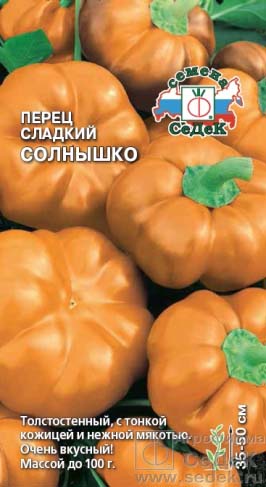
- The variety is mid-season (110-120 days).
- For open ground and film shelters.
- The plant is medium-sized, compact, 35-50 cm high.
- Fruits are round-flat (tomato-shaped), ribbed, glossy, smooth, light-green in technical ripeness, and orange-yellow in biological ripeness. The number of nests is 3-4.
- Wall thickness - 6-8 mm.
- Weight - 70-100 grams.
- Productivity - 8 kg per sq.m.
- Excellent taste and technological qualities. With thin skin and tender juicy and sweet pulp.
- Recommended for fresh consumption, conservation and especially for stuffing.
- Resistant to verticillary wilt, tolerant to alternaria fruit rot.
Other yellow varieties
Of course, the variety of yellow (orange) peppers is not limited to the varieties described above. So, slightly less popular, but quite good and proven varieties and hybrids of yellow (orange) sweet pepper are:
- Bison yellow;
- The giant is yellow;
- Yellow bouquet;
- Yellow bull;
- Yellow elephant;
- The Star of the East is yellow;
- Golden Pyramid;
- Golden Keg;
- Golden Rain;
- Golden bast shoe;
- Gold bar;
- Gold format;
- Cockatoo yellow;
- Megaton is golden;
- Orange beauty;
- Orange delight;
- Orange giant;
- Orange handsome;
- Orange anniversary;
- Aeneas and many others.
Thus, having carefully studied the varieties of yellow (orange) pepper presented, their descriptions, characteristics and appearance (from the photo), you can easily choose the varieties and hybrids most suitable for your site.
By the way! About, when and how to sow pepper for seedlings correctly, You can find out from this detailed article.

